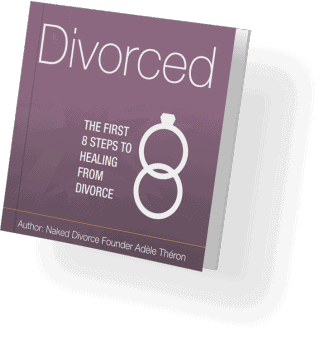
Free e-book: The First 8 Steps to healing from divorce

In her book “On Death and Dying”, Elizabeth Kübler-Ross identifies five stages within the grief cycle. Her multidisciplinary studies and findings have been used extensively throughout the world to describe the several stages of grief that people experience after losing a loved one or a life-changing event, such as a break-up or divorce.
Her findings have undoubtedly changed the psychology world and removed some of the old stigmas around the grieving process. The one thing that Elizabeth and I disagree on, however, is that there are only five stages within the grief process.
I have worked extensively with clients experiencing grief and loss, and I am more comfortable officially splitting the stages of grief into seven stages (and then some). In Kübler-Ross’s five medically reviewed stages, you’ll find:
• Shock/disbelief and denial
• Anger
• Bargaining and guilt
• Depression
• Acceptance
However, most people believe that the stages should be split into seven stages, separating shock/disbelief from denial and bargaining from guilt.
• Shock/disbelief
• Denial
• Anger
• Bargaining
• Guilt
• Depression
• Acceptance
The biggest issue I have with the Kübler-Ross five stages of grief model when it comes to a breakup or divorce, it that it tends to skip over some of the in-between stages that I’ve seen my clients go through and that I have been through myself. Find out more about what you don’t know about grief…
These in-between stages are essential for recovery after a divorce or break up if you are seeking realistic solutions to your situation. Every step needs to be experienced, felt, and dealt with if you are ever going to find a way forward.
In fact, Naked Divorce has ten stages when dealing with grief from a breakup or divorce, and that doesn’t include the initial shock stage! I’m going to explain these to you in more detail.
Keep in mind that everyone experiences grief differently. However, the shock stage is one that is always a precursor to the grief and loss cycle. It is a relatively stable state; even if you know your relationship is on the rocks, the final break undeniably comes as a shock to your system.
From here, the Naked Divorce Grieving Cycle goes as follows:
1. Denial: After the initial shock of finding out your loved one wants to break up or get a divorce, it’s only natural to try and avoid what you know is inevitable. Many people will deny that their marriage or relationship has come to an end and will do everything in their power to avoid dealing with it.
2. Anger and Betrayal: How could your partner possibly do this to you? After all, you have given to them and done for them? This is the stage where a grieving person lets their emotions come to the surface. They are angry and feel like their partner has betrayed their trust and their relationship.
3. Panic and negotiation: Just some of the things you’re likely to say in this stage include: “If you stay, I promise to change!” “I will get into shape for you!” and much more. This is where you try and make any kind of deal with your partner and the world to try and change the situation.
4. Humiliation, Fear of Failure, or Looking Bad: This is where you spiral into self-depreciation. You don’t want to go into public, you avoid seeing your friends and family. You feel humiliated that your partner has cheated on you/ended things with you. This usually comes from the societal stigma around divorce and breakups, especially at an older age.
5. Despair: That awful feeling knowing that something horrible is going to happen and there’s no way that you can avoid it.
6. Loss, Grief and Depression: The heart wrenching realization that the inevitable is going to happen. This is when you enter the true grieving stage and surrender yourself to it.
7. Space and Nothingness: You have spent what feels like forever grieving and crying for the loss of your relationship. Suddenly you don’t feel anything. Your bottomless well of tears has dried up.
8. Acceptance: Accepting what has happened. This is when you start looking towards finding the best way to move forward.
9. Responsibility and Forgiveness: This is where you accept that you may have also had a part to play in the breakdown of your relationship. You take responsibility for your part and learn to forgive yourself and your ex for both of your actions you felt contributed to your relationship not working out.
10. Gratitude: This is an incredibly important thing when it comes to healing. It’s a transformational experience where you can look back and learn lessons from your divorce, taking in the negatives and positives.
What is the best way to manage the stages of grief after a divorce or breakup?
First things first, you have to realize that everyone deals with grief differently and in their own time. Some people might sail through the stages and get to the gratitude stage before they know it. Others may stay stuck in a stage for ages, and some may double back and experience a number of stages more than once. There is no right or wrong way to handle or manage your grief.
It’s important, though, that you don’t try to get through the process alone. Ensure that you have close friends or family to rely on or seek the help of a health care professional and mental health professional if you feel like you are really struggling.
Naked Divorce helps you to understand where you are in the stages of grief and how to manage each stage in order to move on to the next in your own time. The end of your relationship is certainly not the end of your life and with this program, you’ll be looking forward to a bright and rewarding future with a renewed sense of purpose and confidence.
If you enjoyed this post, I’d be very grateful if you’d help it spread by emailing it to a friend, or sharing it on Twitter or Facebook.
With you in service

 Book a Clarity Call for any divorce or break up support you need,
Book a Clarity Call for any divorce or break up support you need,

